You are using an out of date browser. It may not display this or other websites correctly.
You should upgrade or use an alternative browser.
You should upgrade or use an alternative browser.
Grand Alter Saber 2
- Added by FlyingTofuWeasel
- Create date
-
- Tags
- riku rikubuds rikudougoku
o0genesis0o
Headphoneus Supremus
Pros: + Excellent treble details and extension
+ Clean and snappy bass response
+ Very comfortable
+ Clean and snappy bass response
+ Very comfortable
Cons: - The midrange can sound slightly tinny or nasally depending on the track
- Soundstage is more intimate than what I want to hear from earbuds
- Soundstage is more intimate than what I want to hear from earbuds
If you have been around the head-fi communities for a while, you would likely have come across @RikudouGoku, a fellow head-fier and reviewer. In fact, the first expensive IEM that I ever bought was done blindly based on Riku’s review.
Besides reviewing, Riku is also a tinkerer who retunes IEMs and makes earbuds. In fact, he has built up quite an impressive “RikuBuds” line up. Today, we look at the fruit of his labour, the EUR $125 TOTL earbuds called Grand Alter Saber 2 (GAS2).
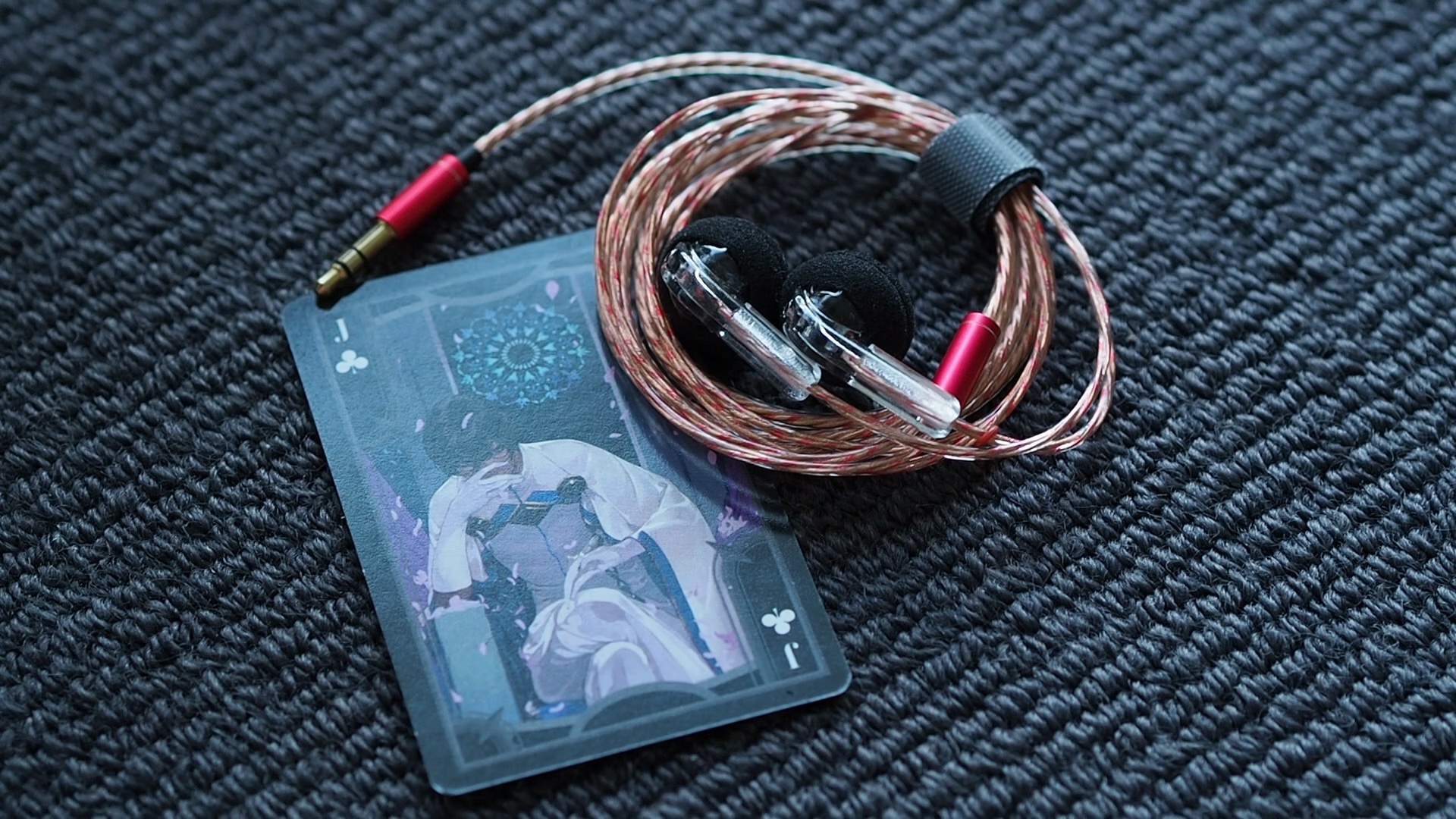


Accessories: The accessories included with the Grand Alter Saber 2 (GAS2) earbuds consist of an OEM case, multiple pairs of earbud foams, and an ID card featuring an anime character.
Stock cable: The cable provided with the GAS2 earbuds is thin and stiff. It tends to retain its coiled shape when stored in the case for an extended period. However, with regular use, it becomes more pliable and generally behaves well. It’s worth noting that the cable terminates with a 3.5mm termination. The cable’s uniform color scheme and the plug are appealing.

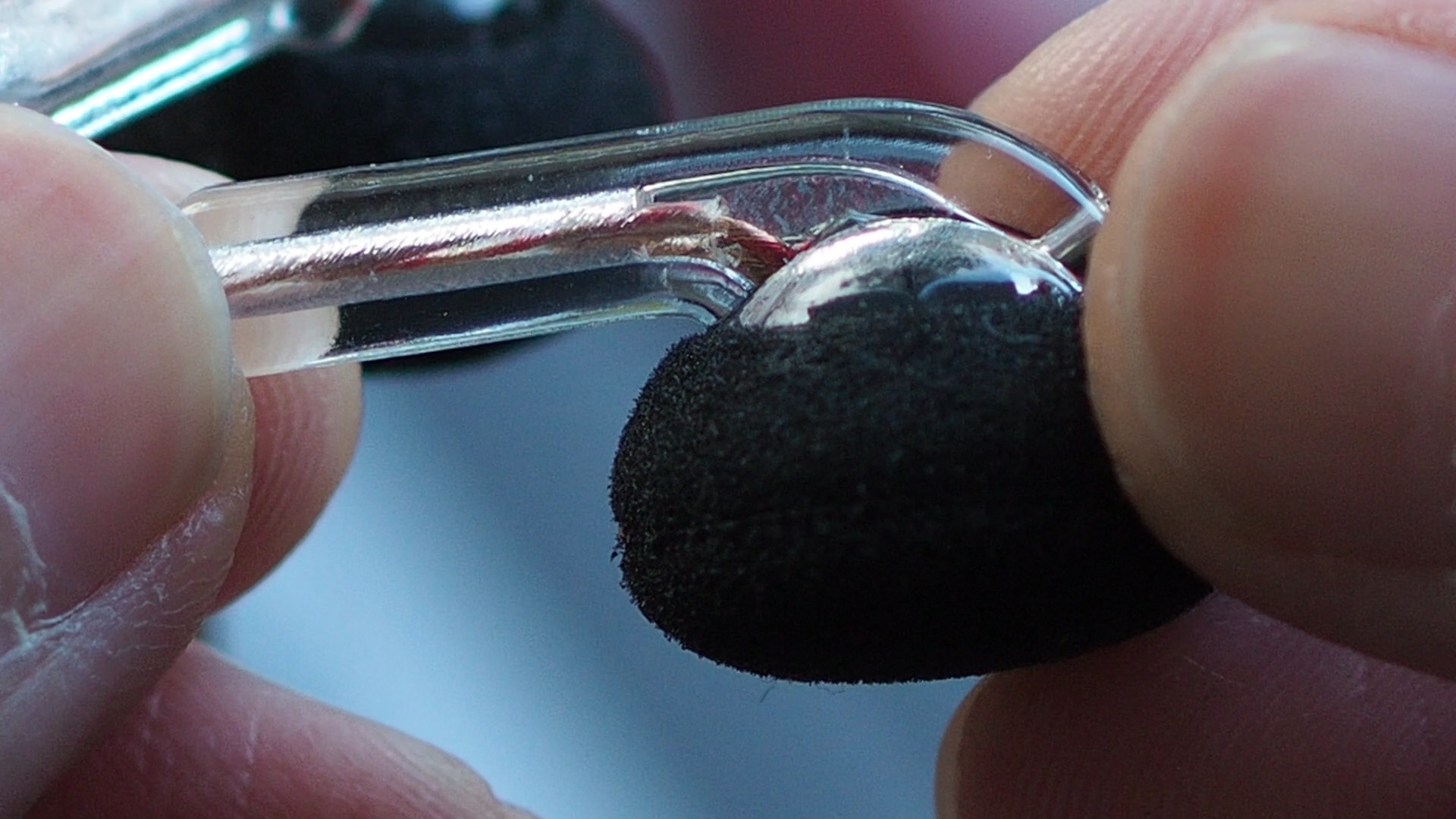


 Earpieces: One notable aspect of the GAS2 earbuds is the design of the earpieces. The material used in the construction of the earpieces feels similar to the 3D printed shells found in the Moondrop Blessing 2 earphones. However, the driver size appears to be the usual 15.4mm. So, if you have difficulty wearing MX500-based earbuds, it’s unlikely that the GAS2 will resolve that issue.
Earpieces: One notable aspect of the GAS2 earbuds is the design of the earpieces. The material used in the construction of the earpieces feels similar to the 3D printed shells found in the Moondrop Blessing 2 earphones. However, the driver size appears to be the usual 15.4mm. So, if you have difficulty wearing MX500-based earbuds, it’s unlikely that the GAS2 will resolve that issue.
Comfort and isolation: The GAS2 earbuds provide a comfortable fit as they rest lightly against the concha of the ears. However, it’s important to note that they do not offer a tight seal, resulting in minimal noise isolation.
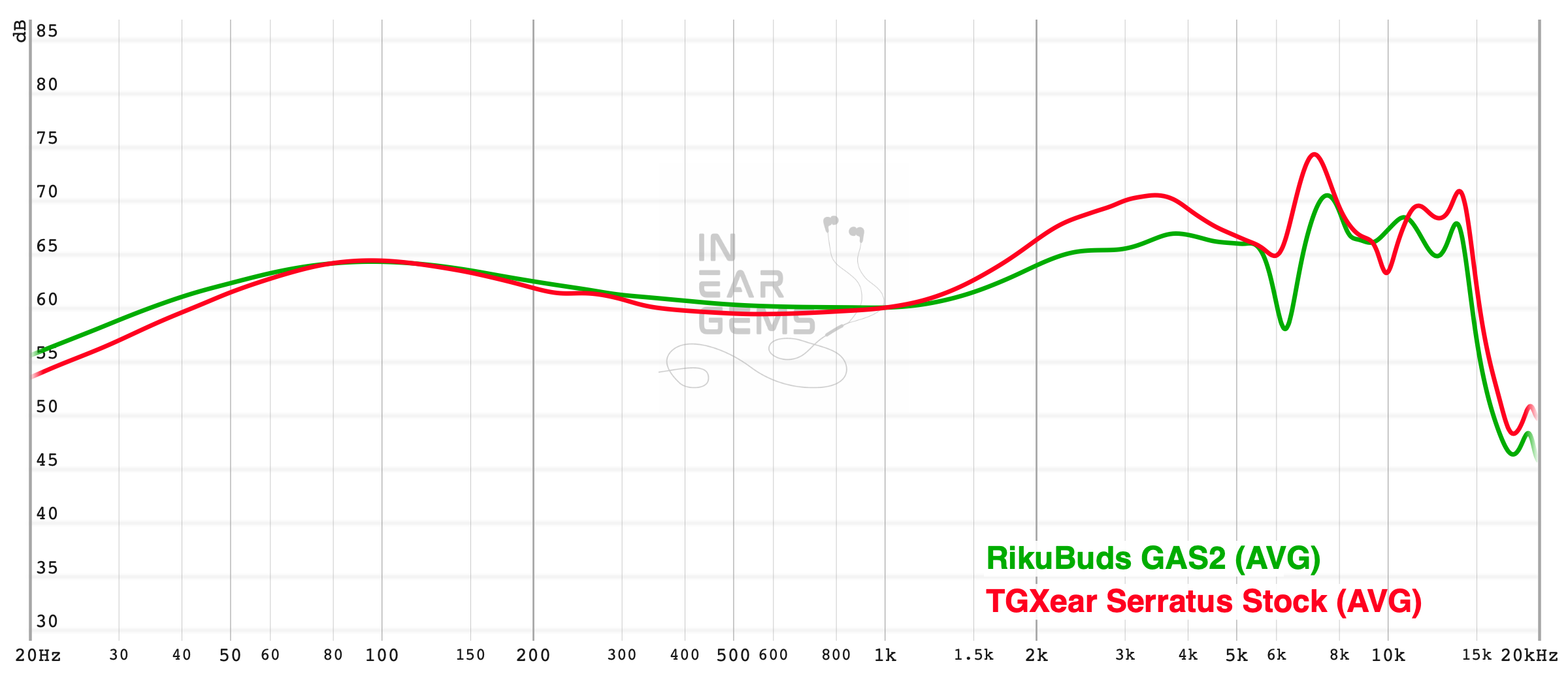
Tonality or “tuning” is where objectivity and subjectivity meet. Objectivity exists in the squiggly lines above, called Frequency Response (FR) graphs. They are created by sweeping a signal from 20Hz to 20kHz and measuring the corresponding loudness coming from an IEM. Unless a human operator deliberately tampers with the microphone or the data, FR does not care about the price or prestige of an IEM and, therefore, is “objective.”
However, human listeners are not microphones. Our ears and brain interpret the sound and decide whether it is “enjoyable.” It is also beneficial to remember that when you play a note on a musical instrument, multiple sounds (fundamental and harmonic) appear simultaneously and mix together. Achieving a life-like balance between frequencies and adding a tasteful amount of imbalance (“colouring the sound”) is the hallmark of an excellent tonality.
Sound signature: The overall sound signature of the Grand Alter Saber 2 (GAS2) can be described as “mid-centric.” It shares similarities in tonality and timbre with the Etymotic ER2SE, which is known for its natural and tonally accurate midrange representation. However, the ER2SE seems to have a slightly more pronounced upper midrange, resulting in edgier vocals compared to the GAS2. The GAS2, on the other hand, offers better mid-treble presence and improved treble extension, allowing for better ambience and spaciousness in the sound. Additionally, being earbuds, the GAS2 benefits from a more open soundstage. The bass response of the GAS2 is relatively subdued compared to the midrange and treble, but there is a hump in the bass region that provides a tactile and snappy sensation to bass hits.
It’s worth addressing the feedback regarding the GAS2 sounding “nasally.” This perception can vary depending on what the listener is accustomed to. For those transitioning from IEMs with more “creatively tuned sound profiles” like the U12T, Andromeda, and Meteor, the vocals on the GAS2 might initially seem too forward or somewhat unnatural. However, with a fresh perspective after a few days, I couldn’t consistently replicate this uncanny sensation, especially with vocal musics.
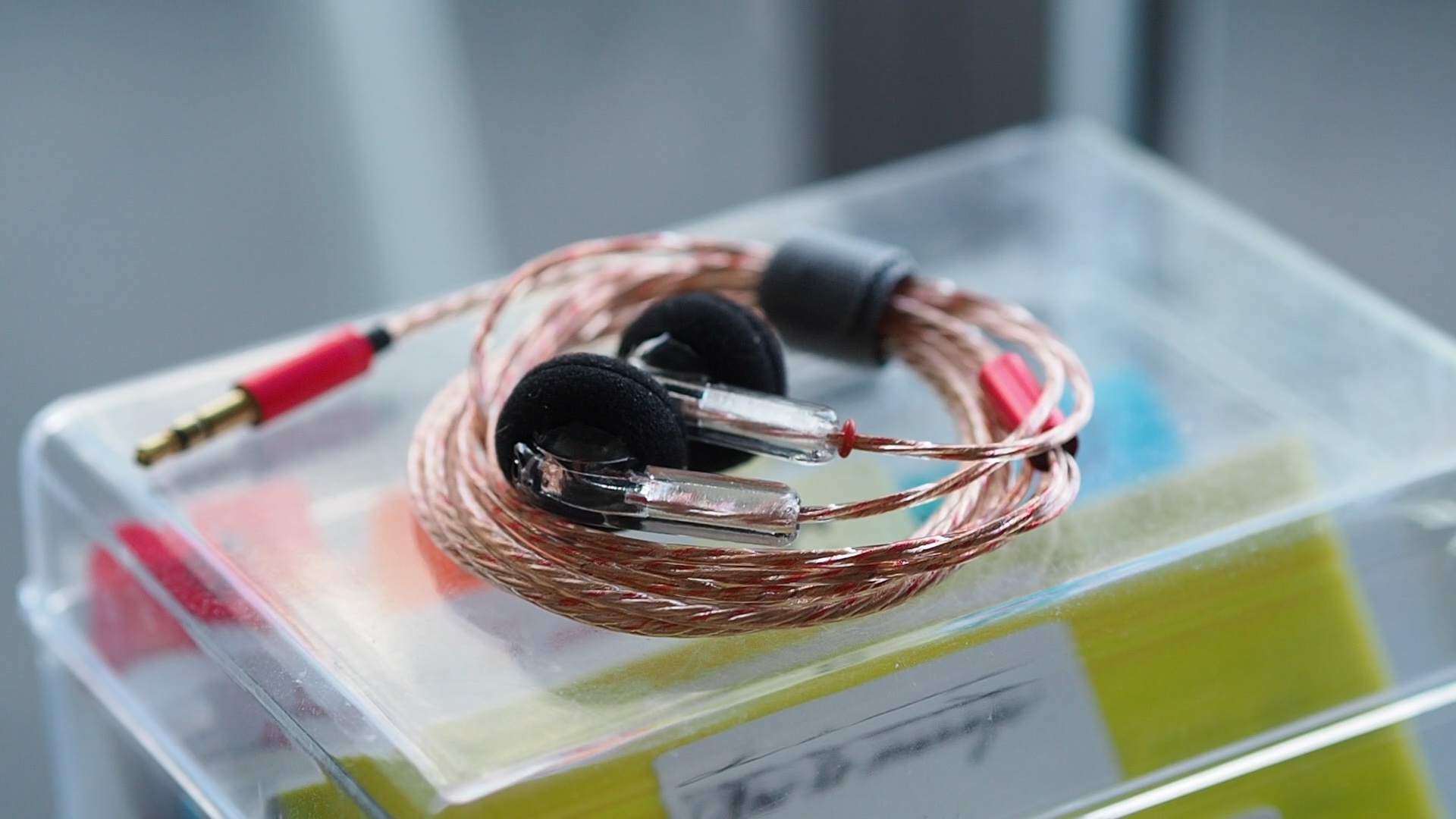
Vocals (Jolene by Pentatonix & Dolly Parton): The vocals on the GAS2 sound life-like. Dolly Parton’s voice in this particular track is prominently highlighted within the mix. There is no noticeable sibilance, similar to the experience with the ER2SE. Both male and female vocals do not show harshness or shoutiness, and there is a good amount of texture and detail in the vocals, slightly surpassing the ER2SE. However, the staging of the vocals is relatively intimate because all vocals are places tightly around the center of the stage, within my head.
Strings and orchestras (Winter by Freivogel and Voices of Music): Thanks to the excellent treble extension, the GAS2 exhibits an much better performance in terms of soundstage and imaging with this track compared to the ER2SE. At times, GAS2 tricks me into thinking that I am in the same room with the orchestra. However, upon listening carefully to the soloist, I detected a slight unnaturalness in the tonality and timbre of the violin. The GAS2 renders the violins with a more metallic and tinny character compared to other IEMs or earbuds in the my collection. I suspect a slight imbalance in the tonality, possibly between the lower-midrange, mid-midrange, and upper-midrange regions.
Drums and bass (Battle Bar): Compared to the ER2SE, the GAS2 exhibits a noticeable boost in bass loudness. However, the overall amount or loudness of the bass is unlikely to impress bass enthusiasts. Nevertheless, I am impressed by the tactility and snappy sensation of the bass. The way the bass diffuses and resonates across the soundstage is also notable, offering an experience that the ER2SE, due to its lack of bass and treble extension, cannot replicate.
Cymbals, hi-hats, chimes (Eye of the Tiger by Survivor): Cymbals and hi-hats on the GAS2 are present in the mix without being buried or excessively pronounced. The GAS2 exhibits less emphasis on treble compared to some of the my other IEMs with U-shaped tuning. The quality of the treble is surprisingly good. I particularly enjoy the additional nuances and texture that can be heard in the tail end of cymbals and hi-hats.

Stereo imaging or “soundstage” is a psychoacoustic illusion that different recording elements appear at various locations inside and around your head. Your brain creates based on the cues in the recording, which are enhanced or diminushed by your IEMs, your DAC, and your amplifier. Some IEMs present a wide but flat soundstage. Some present a “3D” soundstage with layering, depth, and height. In rare cases, with some specific songs, some IEMs can trick you into thinking that the sound comes from the environment (a.k.a., “holographic”)
Soundstage imaging with music (One Winged Angel by the Danish National Symphony Orchestra): When listening to “One Winged Angel” by the Danish National Symphony Orchestra, the soundstage presented by the GAS2 feels relatively flat but positioned in front of me, creating a convincing illusion of depth. There are moments when the GAS2 successfully transports me to a seat in front of the orchestra. However, while the imaging accuracy of the GAS2 is good, it doesn’t reach the level of being exceptionally precise. I can generally discern the overall direction of the instruments on the stage, but their positioning doesn’t feel tack sharp or incredibly stable. While the GAS2 avoids the “wall of sound” effect often found in midrange-focused IEMs or earbuds, the sense of layering within the soundstage is not particularly strong. This means that I don’t experience a distinct contrast between instruments that are closer or further away. On a positive note, the GAS2’s good treble extension allows me to perceive more of the ambience and reverberation of the concert hall. The open design of the earbuds also contributes to an improved sense of soundstage.
Soundstage imaging with games (CS GO Gameplay by Throneful): The GAS2’s flat and wide soundstage is clearly demonstrated when playing FPS games. I can easily identify sounds coming from the sides and determine their approximate distance. However, when gunshots or footsteps originate from the front or directly behind the character, I find it more challenging to gauge the precise distance.

Resolution is a fascinating subject due to the difficulty of pinning down what it really is. To me, “resolution” can be broken down into three components:
Clarity and Separation (Jolene by Pentatonix & Dolly Parton): When listening to the dense track “Jolene” by Pentatonix & Dolly Parton, it serves as an excellent test for evaluating the clarity and separation of an IEM or earbuds. In this regard, the GAS2 delivers an adequate level of clarity and separation that is comparable to what you would expect from a good single dynamic driver (DD) IEM, such as the Moondrop Aria. With some effort, I am able to distinguish individual voices, although the higher voices, particularly Dolly Parton’s, have a tendency to mask the quieter voices. The masking becomes more pronounced with lower voices, as they are further overshadowed by the higher voices.

Detail retrieval and ambience (Paganini Caprice 24 by Daniel Lozakovich): The GAS2 showcases adequate texture and micro-detail reproduction when listening to the violin performance of “Paganini Caprice 24” by Daniel Lozakovich. Its performance in this aspect is similar to what you would expect from a good single DD IEM, like the Moondrop Aria. While it does capture some nuanced elements, such as finger tapping on the fingerboard or the subtle sympathetic vibration of the violin, these details come across as soft and brushed over, requiring me to increase the volume and pay careful attention. However, where the GAS2 surpasses expectations is in its treble extension. It effectively reproduces the ambience and reverberation of the recording room, creating a strong illusion of being present in the actual recording hall.

Test tracks:
Apple dongle: When testing the GAS2 with the Apple dongle, I wasn’t expecting to hear a noticeable difference in sound quality. However, to my surprise, the difference was rather striking, and unfortunately, not in a positive way. I personally did not enjoy how the GAS2 sounded with the Apple dongle at all. Compared to the K7 pairing, where the soundstage felt spacious with instruments spread out and the bass upfront, the Apple dongle pairing resulted in a squished and closed-in soundstage, like a blob in the middle. The disparity between the K7 and Apple dongle experiences was significant enough for me not to recommend the Apple dongle pairing, unless you specifically prefer an intimate and forward presentation.
Average dongle (FiiO KA3): On the other hand, when using the GAS2 with the FiiO KA3 dongle, the sound quality came quite close to the level achieved with the GAS2 + K7 pairing. Personally, I still prefer the center image to be pulled away from me slightly, as opposed to the forward presentation of the KA3. However, overall, the GAS2 + KA3 pairing still sounds very good, and I can confidently recommend this combination.
Bonus comparison (Hidizs XO): Interestingly, the Hidizs XO performed almost identically to the K7 pairing. In fact, the presentation of the XO was surprisingly slightly crisper and more punchy compared to the K7.

Tonality:
The tonality of the GAS2 can be described as mid-focused, similar to the ER2SE. In general, it sounds natural and tonally correct. However, there are instances where the tonality can come across as tinny or nasally, especially when transitioning from IEMs or earbuds with stronger lower or upper midrange. Overall, I consider the tonality of the GAS2 to be adequate, without leaning too positively or negatively (3/5).
Percussion Rendering: Aria (3/5) < GAS2 (4/5) < Blessing 2 (4/5) < U12T / E5000 (5/5)
Compared to the Aria, the GAS2 demonstrates a step up in percussion rendering. I personally enjoy the bass performance of the GAS2, despite it having a relatively modest amount of bass boost. The bass extension is good, and it delivers a snappy, tactile, and high-quality bass response. In terms of percussion rendering, I rate the GAS2 as good (4/5), surpassing the performance of an average IEM or earbuds.
Resolution: SE215 (3/5) < GAS2 (4/5) = Blessing 2 (4/5) < Andromeda 2020 (4.5/5) < U12T (5/5)
When it comes to resolution, I have mixed thoughts about the GAS2. On one hand, it excels in treble extension, allowing it to reveal ambience, reverberation, and micro details that even a good IEM might struggle to reproduce. On the other hand, the midrange doesn’t exhibit the same level of incisiveness and separation that I would expect from a “good” rating. Ultimately, considering the rarity of good treble extension, I believe it deserves more weight in the assessment. Thus, I consider the resolution of the GAS2 as good (4/5), comparable to many mid-fi IEMs.
Soundstage: SE215 (3/5) < GAS2 (4/5) = Blessing 2 (4/5) < Andromeda 2020 (5/5)
Similarly, my thoughts on the soundstage of the GAS2 are somewhat conflicting. The treble extension contributes to creating a holographic illusion, especially with live recordings in real concert halls. However, the tuning of the soundstage tends to focus tightly around a central point, typically inside my head, which can sometimes make the GAS2 feel small under certain configurations. Despite this, I believe the holography illusion created by the great treble extension deserves recognition. Therefore, I rate the soundstage imaging of the GAS2 as good (4/5).
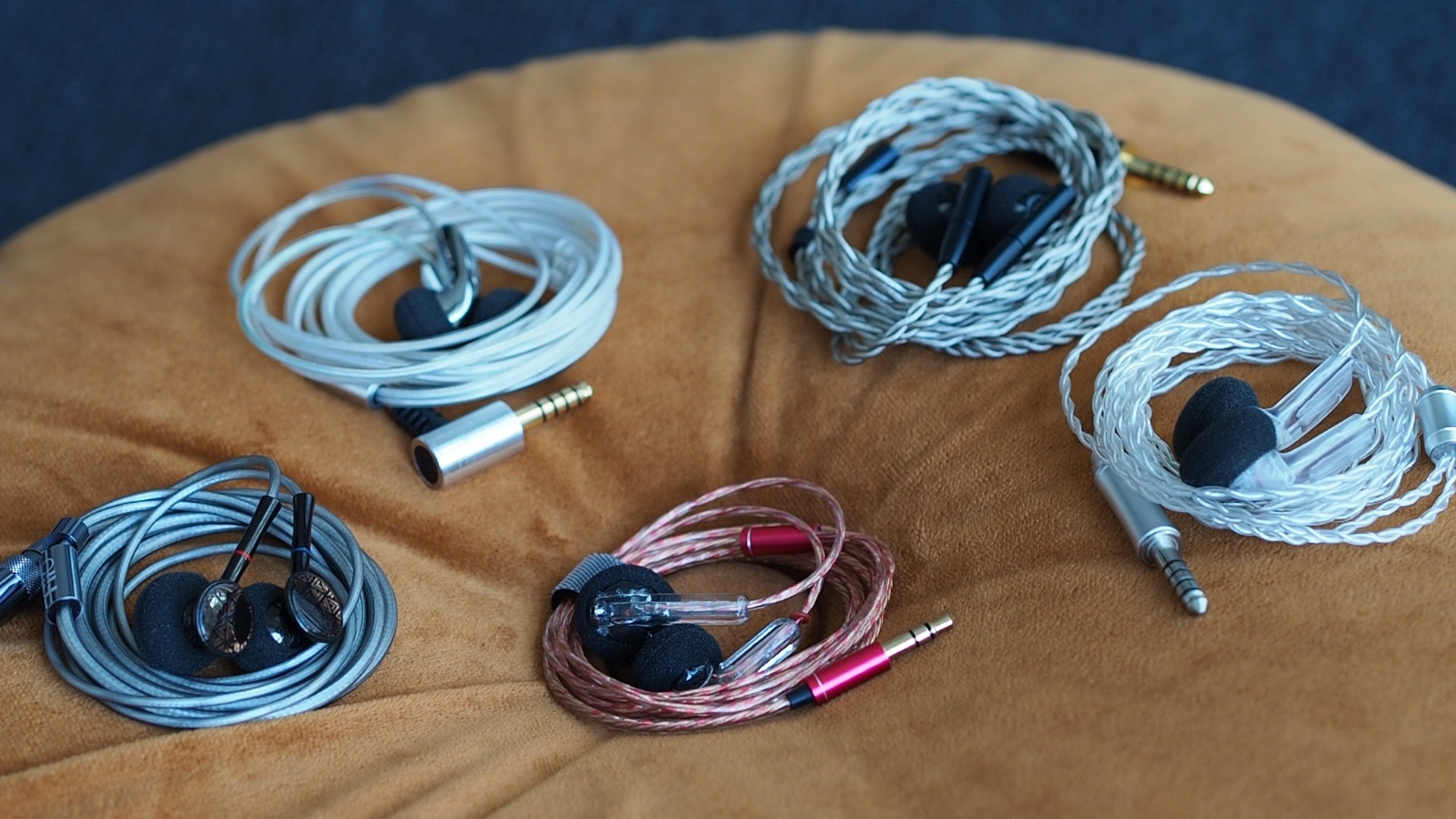
Test tracks:
Vs TGXear Serratus: When comparing the GAS2 to the TGXear Serratus, I noticed a few differences. The Serratus requires more volume than the GAS2 to achieve a similar listening level. Additionally, both earbuds share a similar overall timbre, suggesting that their dynamic drivers may come from the same family. However, the Serratus sounds noticeably brighter than the GAS2, with more presence in the upper midrange and treble. As a result, the Serratus also sounds slightly thinner compared to the GAS2.
In terms of soundstage, the Serratus offers a more open and larger presentation with greater gaps between instruments. On the other hand, the GAS2 presents a denser stereo image that feels more closed in by comparison. Nevertheless, both earbuds provide a more spacious soundstage than most IEMs. When it comes to bass, the Serratus focuses more on the sub-bass, while the GAS2 emphasizes mid-bass punches. Both earbuds outperform average pairs of earbuds, such as the VE Master. In terms of resolution, the Serratus exhibits noticeable superiority over the GAS2, especially when both are amped up to their full potential.
Vs FiiO FF5: Comparing the GAS2 to the FiiO FF5, I observed some differences in their sound signature. The midrange of the FF5 feels more V-shaped compared to the more linear presentation of the GAS2. Vocals and instruments on the FF5 sound more “chesty” and slightly veiled, with the upper midrange boosted to compensate for the lower-midrange veil. In contrast, the GAS2 keeps the midrange more balanced.
The bassline of the FF5 feels more impactful, likely due to better sub-bass extension, but it also appears slightly blurrier and less controlled compared to the GAS2. In terms of technical performance, including resolution, staging, and imaging, the GAS2 slightly outperforms the FF5. The treble details are better reproduced by the GAS2, and the overall stereo image is slightly sharper.
Vs FiiO FF3: When comparing the GAS2 to the FiiO FF3, I noticed distinct differences in their tuning. The FF3 exhibits a downward-sloped tuning, offering significantly more lower-end emphasis and less upper-end presence compared to the GAS2. The bass performance of the FF3 surpasses that of many other earbuds, including the GAS2.
Although the GAS2 demonstrates slightly superior technical performance overall, the tuning and slightly blurred sound of the FF3 work together to create a more immersive listening experience, giving the impression of a “large” sound with enhanced depth.
However, there are a couple of drawbacks to consider. The midrange of the GAS2 can sometimes sound slightly tinny or nasally, depending on the track being played. Furthermore, the soundstage of the earbuds is more intimate than what some listeners (me) may prefer.
In terms of target audience, these IEMs are particularly suitable for individuals who are tired of inserting IEMs into their ear canals or experiencing discomfort from headphones that put pressure on their heads. If you enjoy the sound signature of Etymotic earphones but prefer less upper midrange energy, the GAS2 is a good alternative. It continues to surprise me how well these open earbuds handle treble extension.
Pros
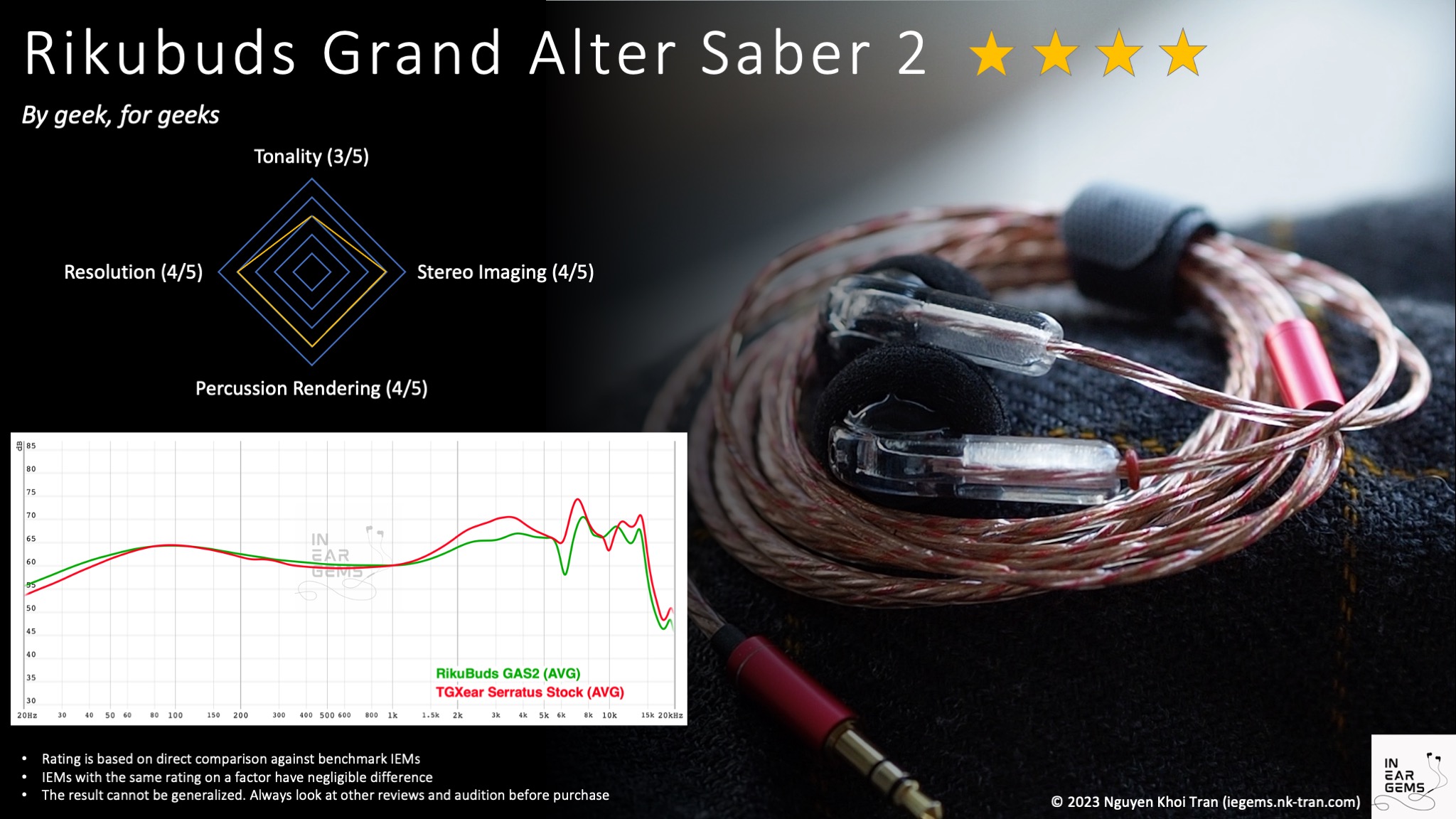
Updated: June 4, 2023
Besides reviewing, Riku is also a tinkerer who retunes IEMs and makes earbuds. In fact, he has built up quite an impressive “RikuBuds” line up. Today, we look at the fruit of his labour, the EUR $125 TOTL earbuds called Grand Alter Saber 2 (GAS2).

Forewords
- What I look for in an IEM is immersion. I want to feel the orchestra around me, track individual instruments, and hear all of their textures and details. I’m not picky about tonality, as long as it does not get in the way of immersion.
- I rate IEMs within with a consistent scale from 1 (poor) to 3 (Adequate) to 5 (outstanding). Ratings are assigned by A/B tests against benchmark IEMs, regardless of the retail price.
- Ranking list and measurement database are on my IEM review blog.
- This review is possible thanks to the generosity of @Tzenn who loaned me his personal unit (Thank you!). I have no affiliation with or financial interest in Rikubuds. The unit retails for EUR $125 at the time this review was published. You can contact Riku directly to order your unit.
Listening Setup
Source chains for listening tests:- Reference Chain: MacBook -> FiiO K7
- Portable Setup: Shanling M6 Ultra
- Dongle: FiiO KA3
Specs
- Driver: 80ohm light blue PET
- Shells: Val39
- Connector Type: Fixed cable
- Impedance: 80ohm
- Sensitivity: unknown
Build and Comfort


Accessories: The accessories included with the Grand Alter Saber 2 (GAS2) earbuds consist of an OEM case, multiple pairs of earbud foams, and an ID card featuring an anime character.
Stock cable: The cable provided with the GAS2 earbuds is thin and stiff. It tends to retain its coiled shape when stored in the case for an extended period. However, with regular use, it becomes more pliable and generally behaves well. It’s worth noting that the cable terminates with a 3.5mm termination. The cable’s uniform color scheme and the plug are appealing.





Comfort and isolation: The GAS2 earbuds provide a comfortable fit as they rest lightly against the concha of the ears. However, it’s important to note that they do not offer a tight seal, resulting in minimal noise isolation.
Tonality
Frequency response of GAS2 against the Serratus. Measurements were done with an IEC-711-compliant coupler and might only be compared with other measurements from this same coupler. Visit my graph database for more comparisons.
Tonality or “tuning” is where objectivity and subjectivity meet. Objectivity exists in the squiggly lines above, called Frequency Response (FR) graphs. They are created by sweeping a signal from 20Hz to 20kHz and measuring the corresponding loudness coming from an IEM. Unless a human operator deliberately tampers with the microphone or the data, FR does not care about the price or prestige of an IEM and, therefore, is “objective.”
However, human listeners are not microphones. Our ears and brain interpret the sound and decide whether it is “enjoyable.” It is also beneficial to remember that when you play a note on a musical instrument, multiple sounds (fundamental and harmonic) appear simultaneously and mix together. Achieving a life-like balance between frequencies and adding a tasteful amount of imbalance (“colouring the sound”) is the hallmark of an excellent tonality.
Sound signature: The overall sound signature of the Grand Alter Saber 2 (GAS2) can be described as “mid-centric.” It shares similarities in tonality and timbre with the Etymotic ER2SE, which is known for its natural and tonally accurate midrange representation. However, the ER2SE seems to have a slightly more pronounced upper midrange, resulting in edgier vocals compared to the GAS2. The GAS2, on the other hand, offers better mid-treble presence and improved treble extension, allowing for better ambience and spaciousness in the sound. Additionally, being earbuds, the GAS2 benefits from a more open soundstage. The bass response of the GAS2 is relatively subdued compared to the midrange and treble, but there is a hump in the bass region that provides a tactile and snappy sensation to bass hits.
It’s worth addressing the feedback regarding the GAS2 sounding “nasally.” This perception can vary depending on what the listener is accustomed to. For those transitioning from IEMs with more “creatively tuned sound profiles” like the U12T, Andromeda, and Meteor, the vocals on the GAS2 might initially seem too forward or somewhat unnatural. However, with a fresh perspective after a few days, I couldn’t consistently replicate this uncanny sensation, especially with vocal musics.

Vocals (Jolene by Pentatonix & Dolly Parton): The vocals on the GAS2 sound life-like. Dolly Parton’s voice in this particular track is prominently highlighted within the mix. There is no noticeable sibilance, similar to the experience with the ER2SE. Both male and female vocals do not show harshness or shoutiness, and there is a good amount of texture and detail in the vocals, slightly surpassing the ER2SE. However, the staging of the vocals is relatively intimate because all vocals are places tightly around the center of the stage, within my head.
Strings and orchestras (Winter by Freivogel and Voices of Music): Thanks to the excellent treble extension, the GAS2 exhibits an much better performance in terms of soundstage and imaging with this track compared to the ER2SE. At times, GAS2 tricks me into thinking that I am in the same room with the orchestra. However, upon listening carefully to the soloist, I detected a slight unnaturalness in the tonality and timbre of the violin. The GAS2 renders the violins with a more metallic and tinny character compared to other IEMs or earbuds in the my collection. I suspect a slight imbalance in the tonality, possibly between the lower-midrange, mid-midrange, and upper-midrange regions.
Drums and bass (Battle Bar): Compared to the ER2SE, the GAS2 exhibits a noticeable boost in bass loudness. However, the overall amount or loudness of the bass is unlikely to impress bass enthusiasts. Nevertheless, I am impressed by the tactility and snappy sensation of the bass. The way the bass diffuses and resonates across the soundstage is also notable, offering an experience that the ER2SE, due to its lack of bass and treble extension, cannot replicate.
Cymbals, hi-hats, chimes (Eye of the Tiger by Survivor): Cymbals and hi-hats on the GAS2 are present in the mix without being buried or excessively pronounced. The GAS2 exhibits less emphasis on treble compared to some of the my other IEMs with U-shaped tuning. The quality of the treble is surprisingly good. I particularly enjoy the additional nuances and texture that can be heard in the tail end of cymbals and hi-hats.
Soundstage Imaging

Stereo imaging or “soundstage” is a psychoacoustic illusion that different recording elements appear at various locations inside and around your head. Your brain creates based on the cues in the recording, which are enhanced or diminushed by your IEMs, your DAC, and your amplifier. Some IEMs present a wide but flat soundstage. Some present a “3D” soundstage with layering, depth, and height. In rare cases, with some specific songs, some IEMs can trick you into thinking that the sound comes from the environment (a.k.a., “holographic”)
Soundstage imaging with music (One Winged Angel by the Danish National Symphony Orchestra): When listening to “One Winged Angel” by the Danish National Symphony Orchestra, the soundstage presented by the GAS2 feels relatively flat but positioned in front of me, creating a convincing illusion of depth. There are moments when the GAS2 successfully transports me to a seat in front of the orchestra. However, while the imaging accuracy of the GAS2 is good, it doesn’t reach the level of being exceptionally precise. I can generally discern the overall direction of the instruments on the stage, but their positioning doesn’t feel tack sharp or incredibly stable. While the GAS2 avoids the “wall of sound” effect often found in midrange-focused IEMs or earbuds, the sense of layering within the soundstage is not particularly strong. This means that I don’t experience a distinct contrast between instruments that are closer or further away. On a positive note, the GAS2’s good treble extension allows me to perceive more of the ambience and reverberation of the concert hall. The open design of the earbuds also contributes to an improved sense of soundstage.
Soundstage imaging with games (CS GO Gameplay by Throneful): The GAS2’s flat and wide soundstage is clearly demonstrated when playing FPS games. I can easily identify sounds coming from the sides and determine their approximate distance. However, when gunshots or footsteps originate from the front or directly behind the character, I find it more challenging to gauge the precise distance.
Resolution

Resolution is a fascinating subject due to the difficulty of pinning down what it really is. To me, “resolution” can be broken down into three components:
- Sharpness, incisiveness, or “definition” of note attacks (see the figure above).
- The separation of instruments and vocals, especially when they overlap on the soundstage.
- The texture and details in the decay side of the notes.
Clarity and Separation (Jolene by Pentatonix & Dolly Parton): When listening to the dense track “Jolene” by Pentatonix & Dolly Parton, it serves as an excellent test for evaluating the clarity and separation of an IEM or earbuds. In this regard, the GAS2 delivers an adequate level of clarity and separation that is comparable to what you would expect from a good single dynamic driver (DD) IEM, such as the Moondrop Aria. With some effort, I am able to distinguish individual voices, although the higher voices, particularly Dolly Parton’s, have a tendency to mask the quieter voices. The masking becomes more pronounced with lower voices, as they are further overshadowed by the higher voices.

Detail retrieval and ambience (Paganini Caprice 24 by Daniel Lozakovich): The GAS2 showcases adequate texture and micro-detail reproduction when listening to the violin performance of “Paganini Caprice 24” by Daniel Lozakovich. Its performance in this aspect is similar to what you would expect from a good single DD IEM, like the Moondrop Aria. While it does capture some nuanced elements, such as finger tapping on the fingerboard or the subtle sympathetic vibration of the violin, these details come across as soft and brushed over, requiring me to increase the volume and pay careful attention. However, where the GAS2 surpasses expectations is in its treble extension. It effectively reproduces the ambience and reverberation of the recording room, creating a strong illusion of being present in the actual recording hall.
Source Pairing

Test tracks:
Apple dongle: When testing the GAS2 with the Apple dongle, I wasn’t expecting to hear a noticeable difference in sound quality. However, to my surprise, the difference was rather striking, and unfortunately, not in a positive way. I personally did not enjoy how the GAS2 sounded with the Apple dongle at all. Compared to the K7 pairing, where the soundstage felt spacious with instruments spread out and the bass upfront, the Apple dongle pairing resulted in a squished and closed-in soundstage, like a blob in the middle. The disparity between the K7 and Apple dongle experiences was significant enough for me not to recommend the Apple dongle pairing, unless you specifically prefer an intimate and forward presentation.
Average dongle (FiiO KA3): On the other hand, when using the GAS2 with the FiiO KA3 dongle, the sound quality came quite close to the level achieved with the GAS2 + K7 pairing. Personally, I still prefer the center image to be pulled away from me slightly, as opposed to the forward presentation of the KA3. However, overall, the GAS2 + KA3 pairing still sounds very good, and I can confidently recommend this combination.
Bonus comparison (Hidizs XO): Interestingly, the Hidizs XO performed almost identically to the K7 pairing. In fact, the presentation of the XO was surprisingly slightly crisper and more punchy compared to the K7.
Comparison and Rating

Tonality:
The tonality of the GAS2 can be described as mid-focused, similar to the ER2SE. In general, it sounds natural and tonally correct. However, there are instances where the tonality can come across as tinny or nasally, especially when transitioning from IEMs or earbuds with stronger lower or upper midrange. Overall, I consider the tonality of the GAS2 to be adequate, without leaning too positively or negatively (3/5).
Percussion Rendering: Aria (3/5) < GAS2 (4/5) < Blessing 2 (4/5) < U12T / E5000 (5/5)
Compared to the Aria, the GAS2 demonstrates a step up in percussion rendering. I personally enjoy the bass performance of the GAS2, despite it having a relatively modest amount of bass boost. The bass extension is good, and it delivers a snappy, tactile, and high-quality bass response. In terms of percussion rendering, I rate the GAS2 as good (4/5), surpassing the performance of an average IEM or earbuds.
Resolution: SE215 (3/5) < GAS2 (4/5) = Blessing 2 (4/5) < Andromeda 2020 (4.5/5) < U12T (5/5)
When it comes to resolution, I have mixed thoughts about the GAS2. On one hand, it excels in treble extension, allowing it to reveal ambience, reverberation, and micro details that even a good IEM might struggle to reproduce. On the other hand, the midrange doesn’t exhibit the same level of incisiveness and separation that I would expect from a “good” rating. Ultimately, considering the rarity of good treble extension, I believe it deserves more weight in the assessment. Thus, I consider the resolution of the GAS2 as good (4/5), comparable to many mid-fi IEMs.
Soundstage: SE215 (3/5) < GAS2 (4/5) = Blessing 2 (4/5) < Andromeda 2020 (5/5)
Similarly, my thoughts on the soundstage of the GAS2 are somewhat conflicting. The treble extension contributes to creating a holographic illusion, especially with live recordings in real concert halls. However, the tuning of the soundstage tends to focus tightly around a central point, typically inside my head, which can sometimes make the GAS2 feel small under certain configurations. Despite this, I believe the holography illusion created by the great treble extension deserves recognition. Therefore, I rate the soundstage imaging of the GAS2 as good (4/5).
Special Comparisons

Test tracks:
Vs TGXear Serratus: When comparing the GAS2 to the TGXear Serratus, I noticed a few differences. The Serratus requires more volume than the GAS2 to achieve a similar listening level. Additionally, both earbuds share a similar overall timbre, suggesting that their dynamic drivers may come from the same family. However, the Serratus sounds noticeably brighter than the GAS2, with more presence in the upper midrange and treble. As a result, the Serratus also sounds slightly thinner compared to the GAS2.
In terms of soundstage, the Serratus offers a more open and larger presentation with greater gaps between instruments. On the other hand, the GAS2 presents a denser stereo image that feels more closed in by comparison. Nevertheless, both earbuds provide a more spacious soundstage than most IEMs. When it comes to bass, the Serratus focuses more on the sub-bass, while the GAS2 emphasizes mid-bass punches. Both earbuds outperform average pairs of earbuds, such as the VE Master. In terms of resolution, the Serratus exhibits noticeable superiority over the GAS2, especially when both are amped up to their full potential.
Vs FiiO FF5: Comparing the GAS2 to the FiiO FF5, I observed some differences in their sound signature. The midrange of the FF5 feels more V-shaped compared to the more linear presentation of the GAS2. Vocals and instruments on the FF5 sound more “chesty” and slightly veiled, with the upper midrange boosted to compensate for the lower-midrange veil. In contrast, the GAS2 keeps the midrange more balanced.
The bassline of the FF5 feels more impactful, likely due to better sub-bass extension, but it also appears slightly blurrier and less controlled compared to the GAS2. In terms of technical performance, including resolution, staging, and imaging, the GAS2 slightly outperforms the FF5. The treble details are better reproduced by the GAS2, and the overall stereo image is slightly sharper.
Vs FiiO FF3: When comparing the GAS2 to the FiiO FF3, I noticed distinct differences in their tuning. The FF3 exhibits a downward-sloped tuning, offering significantly more lower-end emphasis and less upper-end presence compared to the GAS2. The bass performance of the FF3 surpasses that of many other earbuds, including the GAS2.
Although the GAS2 demonstrates slightly superior technical performance overall, the tuning and slightly blurred sound of the FF3 work together to create a more immersive listening experience, giving the impression of a “large” sound with enhanced depth.
Conclusion
GAS2 is clearly pair of earbuds that was crafted with care and love by an audio geek. It excels in treble performance, providing excellent extension. The clean and snappy bass response is another notable advantage of these earbuds. Additionally, they are highly comfortable to wear, ensuring a pleasant listening experience.However, there are a couple of drawbacks to consider. The midrange of the GAS2 can sometimes sound slightly tinny or nasally, depending on the track being played. Furthermore, the soundstage of the earbuds is more intimate than what some listeners (me) may prefer.
In terms of target audience, these IEMs are particularly suitable for individuals who are tired of inserting IEMs into their ear canals or experiencing discomfort from headphones that put pressure on their heads. If you enjoy the sound signature of Etymotic earphones but prefer less upper midrange energy, the GAS2 is a good alternative. It continues to surprise me how well these open earbuds handle treble extension.
Pros
- Excellent treble details and extension
- Clean and snappy bass response
- Very comfortable
- The midrange can sound slightly tinny or nasally depending on the track
- Soundstage is more intimate than what I want to hear from earbuds

Updated: June 4, 2023
Leonarfd
Nice review, the gen 3 that is coming is maybe making the soundstage larger. Probably very different but I soon have the GB2, maybe more similar to your FIIO models in tuning.
o0genesis0o
@Leonarfd Looking forward for your GB2 impressions! I'll be very impressed if Riku matches or stomps the FiiO FF3 without any of bass tube gizmos.
FlyingTofuWeasel
New Head-Fier
Pros: tone/ timbre
dynamic range
stage and imaging
separation/ layering
vocals: Male and Female
bass and treble extension
sensitive to foam thickness
easy to drive: 80 ohms
fairly comfortable shell: val39
dynamic range
stage and imaging
separation/ layering
vocals: Male and Female
bass and treble extension
sensitive to foam thickness
easy to drive: 80 ohms
fairly comfortable shell: val39
Cons: sensitive to foam thickness
slight high-bass/ low-mid hump (subjective)
slight high-bass/ low-mid hump (subjective)
Build/ Accessories:
I was given a choice of cables for the bud and chose a copper cable with a 3.5 termination. The cable is reasonably flexible, twisted copper, with a decent looking termination and small, lightweight hardware. Strain relief clips are visible in the 3D printed Val39 shell so there’s no worry about damaging the solder points. Val39 is slightly more comfortable for me than MX500. Nothing mind blowing or of concern. It's simple, light, functional and sturdy; which is something I welcome from any bud.
Riku’s “grand” class of buds come with a nice big fabric case with many mesh pockets, plenty of foams and a saucy “Fate Grand Order” playing card depicting the character the bud is named for.
Obligatory and Subjective Frequency/ Technicalities Ramble:
The frequency response across the spectrum is arguably bass boosted neutral. The bass is above the mids and treble. The mids are slightly above the treble but not by much. The bud is never-the-less very energetic and has excellent air.
Bass:
The bass is very well extended into the sub-bass region. The sub-bass isn’t at basshead levels by any means but is audible and can be felt with a slight rumble. It should be at a satisfying level for most people and surpasses many buds in quantity and quality. The driver is quite fast to the mild detriment of the bass. The quality of the bass is excellent in the attack but the transients are too fast for the bud to lend itself well to a genre like metal where slow, loose bass is optimal.
The low-bass also provides a bit of a satisfying rumble from the bud while remaining well textured. There’s no mud to be found here, just fast, clean bass.
The mid/ upper-bass can at times be slightly fatiguing for me depending on the song and foams used. Songs that have an excess of kick drum, floor tom or synth in that frequency range can at times be distracting or irritating. The same elevation here helps vocals and mid centric instruments sound appropriately lush and full bodied so I’m willing to overlook it for the most part. It does disqualify this bud from being a true allrounder for me. Though, if you like some extra punch to your bass it may be a plus.
Mids:
Simply put: fantastic. As previously mentioned the bass, while lovely on its own, does an amazing job of supporting the mids. Easily one of the best buds I’ve heard for string orchestral and acoustic guitar; violins and guitars absolutely sing. The fundamentals are spot on. Very good separation and layering of instruments and vocals. Even in busy tracks that tend to get muddled easily, vocals and instruments are clearly defined. Just great fidelity here.
Male and Female vocals, depending on the mastering, float just above the rest of the mix as they should. Male vocals have great depth and warmth. Female vocals are sweet and with thin(er) foams can have some satisfying sparkle. The dynamic range of the bud is exceptional. Chamber choir tracks are nuanced and layered well. Thicker foams seem to recess the mids too much for my taste and destroy female vocals.
Upper-mids and Treble:
Upper-mids/ lower-treble sound very good. They have a pleasing clarity which helps with the tonality of the bud in this harmonic heavy area. While energetic, I don’t find the bud’s upper-mids/ treble fatiguing unless I listen at high volume or find that there’s too much detail being forced on me.
The treble has great detail and does a good job of balancing the bass and mids. Great air and crispness without being fatiguing due to the fast driver and thus quick transients. Very good extension with faithful reproduction of the upper harmonics that add a great deal to the overall tonality, stage and imaging of the bud.
TL;DR: It sounds good.
Gear Used:
Sources:
Fiio New K3, Apple Dongle -> Schiit Magni, Tanchjim Space
Foams:
New white Faaeal foams were used on all buds. The thickness between individual foams is consistent and I consider them to be of a medium density.
Comparisons:
RikuBuds: Grand Berserker 2:
The bass is slower, looser, more lush and there’s simply a lot more of it. As a basshead, it’s lovely. Cellos and other instruments with deep voices that straddle the bass and mids sound more full and accurate compared to the GAS2.
The mids are more recessed and are less tonally correct to my ear for some instruments; though they’re frankly not too far off for the amount of bass the bud has. Male vocals are more rich while female vocals try to sparkle but can’t quite make it most of the time.
Treble on the GB2 is darker and more smoothed. Not fatiguing at all. The upper harmonics and transients are slower and more recessed.
The tonal balance of the bud is heavily shifted towards bass thus dynamic range, stage and imaging that rely on balance, fast treble, lack of distortion etc., etc., aren't on par with the GAS2 because of the slower driver and the tuning.
Great bud for metal, edm, rock and male vocals but less of an all rounder than the GAS2.
Fiio: FF5
The bass is more lean, and slightly hollow sounding in comparison. Sub-bass is rolled off with very little rumble. The bass isn’t as prominent and thus the bud sounds a bit dry. But is pleasantly smoothed in comparison and fades into the background.
String instruments are a bit crisper on the attack and with less bass seem to decay faster leading the timbre to sound less natural. Male and especially female vocals can be a bit harsh at times.
The FF5’s treble is brighter and there's more air. Out of the context of comparison I consider the FF5 to be a fairly neutral bud with a good tonal balance, but in comparison to the GAS2 it sounds quite bright.
The dynamic range of the FF5 is slightly better. The subtle shifts in choir and orchestral volume are a bit easier to follow, likely because of the lower quantity of bass and seeingly faster transients. The stage and imaging are a little more blobby.
K’s Earphones: DB1E
The bud is neutral with good extension. The sub and low bass are pleasantly audible and can be felt with a bit of a rumble when called for by a track. Not as well textured or dynamic as the GAS2. The bass is good but it falls short in comparison.
The rest of the frequency range sounds fairly flat for the most part. Leaning towards being dark it often sounds somewhat lacking. The timbre and note weight sound thin. Male and female vocals sound recessed and, at times, rather lifeless. Treble is well extended and inoffensive.
Dynamic range is about on par, with some subtleties being lost at lower volumes. Stage lacks depth and imaging can be a little left and right focused.
The DB1E is good for putting in your ears and forgetting about; beautifully boring. In comparison to the GAS2 it’s frankly kinda meh.
TGXEAR: Red Serratus:
Similar bass extension with less mid-bass emphasis. Serratus’ bass has more air and better resonance and decay i.e., sounds less dampened. However, bassy instruments don’t have the same weight to their attack and at times sound oddly crisp.
Female vocals have more sparkle. Male vocals are less lush and sound a touch too thin. Female vocals can get lost in the treble at times while listening to busy tracks; sounding almost washed out in the mix. The overall timbre of the bud is slightly too bright to be correct to my ear.
The treble is more fatiguing in longer listening sessions. The upper harmonics and transients sound a little stretched out and are, again, are a bit overly bright to the detriment of the timbre.
Technicalities are quite similar but a bit better across the board on the serratus.
Conclusions (real review):
It’s a great bud in terms of price-performance. Sufficiently bassy and a bit dark, yet well extended, with excellent timbre and techs.
I was given a choice of cables for the bud and chose a copper cable with a 3.5 termination. The cable is reasonably flexible, twisted copper, with a decent looking termination and small, lightweight hardware. Strain relief clips are visible in the 3D printed Val39 shell so there’s no worry about damaging the solder points. Val39 is slightly more comfortable for me than MX500. Nothing mind blowing or of concern. It's simple, light, functional and sturdy; which is something I welcome from any bud.
Riku’s “grand” class of buds come with a nice big fabric case with many mesh pockets, plenty of foams and a saucy “Fate Grand Order” playing card depicting the character the bud is named for.
Obligatory and Subjective Frequency/ Technicalities Ramble:
The frequency response across the spectrum is arguably bass boosted neutral. The bass is above the mids and treble. The mids are slightly above the treble but not by much. The bud is never-the-less very energetic and has excellent air.
Bass:
The bass is very well extended into the sub-bass region. The sub-bass isn’t at basshead levels by any means but is audible and can be felt with a slight rumble. It should be at a satisfying level for most people and surpasses many buds in quantity and quality. The driver is quite fast to the mild detriment of the bass. The quality of the bass is excellent in the attack but the transients are too fast for the bud to lend itself well to a genre like metal where slow, loose bass is optimal.
The low-bass also provides a bit of a satisfying rumble from the bud while remaining well textured. There’s no mud to be found here, just fast, clean bass.
The mid/ upper-bass can at times be slightly fatiguing for me depending on the song and foams used. Songs that have an excess of kick drum, floor tom or synth in that frequency range can at times be distracting or irritating. The same elevation here helps vocals and mid centric instruments sound appropriately lush and full bodied so I’m willing to overlook it for the most part. It does disqualify this bud from being a true allrounder for me. Though, if you like some extra punch to your bass it may be a plus.
Mids:
Simply put: fantastic. As previously mentioned the bass, while lovely on its own, does an amazing job of supporting the mids. Easily one of the best buds I’ve heard for string orchestral and acoustic guitar; violins and guitars absolutely sing. The fundamentals are spot on. Very good separation and layering of instruments and vocals. Even in busy tracks that tend to get muddled easily, vocals and instruments are clearly defined. Just great fidelity here.
Male and Female vocals, depending on the mastering, float just above the rest of the mix as they should. Male vocals have great depth and warmth. Female vocals are sweet and with thin(er) foams can have some satisfying sparkle. The dynamic range of the bud is exceptional. Chamber choir tracks are nuanced and layered well. Thicker foams seem to recess the mids too much for my taste and destroy female vocals.
Upper-mids and Treble:
Upper-mids/ lower-treble sound very good. They have a pleasing clarity which helps with the tonality of the bud in this harmonic heavy area. While energetic, I don’t find the bud’s upper-mids/ treble fatiguing unless I listen at high volume or find that there’s too much detail being forced on me.
The treble has great detail and does a good job of balancing the bass and mids. Great air and crispness without being fatiguing due to the fast driver and thus quick transients. Very good extension with faithful reproduction of the upper harmonics that add a great deal to the overall tonality, stage and imaging of the bud.
TL;DR: It sounds good.
Gear Used:
Sources:
Fiio New K3, Apple Dongle -> Schiit Magni, Tanchjim Space
Foams:
New white Faaeal foams were used on all buds. The thickness between individual foams is consistent and I consider them to be of a medium density.
Comparisons:
RikuBuds: Grand Berserker 2:
The bass is slower, looser, more lush and there’s simply a lot more of it. As a basshead, it’s lovely. Cellos and other instruments with deep voices that straddle the bass and mids sound more full and accurate compared to the GAS2.
The mids are more recessed and are less tonally correct to my ear for some instruments; though they’re frankly not too far off for the amount of bass the bud has. Male vocals are more rich while female vocals try to sparkle but can’t quite make it most of the time.
Treble on the GB2 is darker and more smoothed. Not fatiguing at all. The upper harmonics and transients are slower and more recessed.
The tonal balance of the bud is heavily shifted towards bass thus dynamic range, stage and imaging that rely on balance, fast treble, lack of distortion etc., etc., aren't on par with the GAS2 because of the slower driver and the tuning.
Great bud for metal, edm, rock and male vocals but less of an all rounder than the GAS2.
Fiio: FF5
The bass is more lean, and slightly hollow sounding in comparison. Sub-bass is rolled off with very little rumble. The bass isn’t as prominent and thus the bud sounds a bit dry. But is pleasantly smoothed in comparison and fades into the background.
String instruments are a bit crisper on the attack and with less bass seem to decay faster leading the timbre to sound less natural. Male and especially female vocals can be a bit harsh at times.
The FF5’s treble is brighter and there's more air. Out of the context of comparison I consider the FF5 to be a fairly neutral bud with a good tonal balance, but in comparison to the GAS2 it sounds quite bright.
The dynamic range of the FF5 is slightly better. The subtle shifts in choir and orchestral volume are a bit easier to follow, likely because of the lower quantity of bass and seeingly faster transients. The stage and imaging are a little more blobby.
K’s Earphones: DB1E
The bud is neutral with good extension. The sub and low bass are pleasantly audible and can be felt with a bit of a rumble when called for by a track. Not as well textured or dynamic as the GAS2. The bass is good but it falls short in comparison.
The rest of the frequency range sounds fairly flat for the most part. Leaning towards being dark it often sounds somewhat lacking. The timbre and note weight sound thin. Male and female vocals sound recessed and, at times, rather lifeless. Treble is well extended and inoffensive.
Dynamic range is about on par, with some subtleties being lost at lower volumes. Stage lacks depth and imaging can be a little left and right focused.
The DB1E is good for putting in your ears and forgetting about; beautifully boring. In comparison to the GAS2 it’s frankly kinda meh.
TGXEAR: Red Serratus:
Similar bass extension with less mid-bass emphasis. Serratus’ bass has more air and better resonance and decay i.e., sounds less dampened. However, bassy instruments don’t have the same weight to their attack and at times sound oddly crisp.
Female vocals have more sparkle. Male vocals are less lush and sound a touch too thin. Female vocals can get lost in the treble at times while listening to busy tracks; sounding almost washed out in the mix. The overall timbre of the bud is slightly too bright to be correct to my ear.
The treble is more fatiguing in longer listening sessions. The upper harmonics and transients sound a little stretched out and are, again, are a bit overly bright to the detriment of the timbre.
Technicalities are quite similar but a bit better across the board on the serratus.
Conclusions (real review):
It’s a great bud in terms of price-performance. Sufficiently bassy and a bit dark, yet well extended, with excellent timbre and techs.
itwasluck
I’ve had my GAS2 for a while now and this review is on point. What I love the most is being able to use this on any source without losing any detail, I highly recommend using the Hiegi foam as well. Can’t wait for the Yinman vs. GAS2 comparison!

